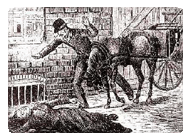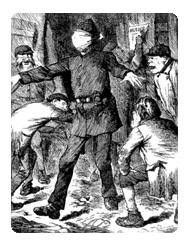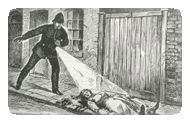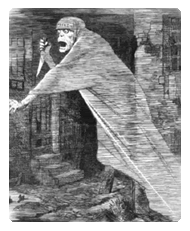Saturday, March 08, 2008
Jack the Ripper had 11 victims?
According to a new story in the East London Advertiser, Jack the Ripper may have been responsible for eleven victims, not the so-called canonical five, based on "new evidence." This story accompanies the Ripper exhibit that is making the rounds in Britain. Now, it's important to say up front that of course we don't know how many victims Jack had for sure. But there are some troubling things in this report. Any person who has studied the case knows that we are hampered not only by the paucity of evidence left, the time that has elapsed and the inexperience of contemporary investigators-we are also hampered by slapdash reporting and perpetuation of myths, which work to obfuscate any serious research.
From the story:
OK. Strange way to shape a sentence there at the end, but whatever. The author knows that a lot has been written about Jack--therefore, it would have been helpful to perhaps scan some of that literature before either repeating incorrect information or being ill-informed altogether.
I'm confused. Wouldn't this be eighteen murders, then?
Uh, that's six. And Emma Smith is NOT considered one of the five.
Is the author saying that these files, which were confidential and had been hidden away for almost a century were marked so in order to alleviate public panic, the public who had no access to the files? In fact, the more important "files" would be the press reports, not because they would be true but because they would better indicate what the public was exposed to in the form of information on the case. And, as the author states earlier, many other murders after Mary Kelly were attributed to Jack even though no proof has held up in those cases.
The case was widely reported, especially as Wynne Baxter, the coroner in some of the Ripper victims' cases, was the coroner in this case as well. In fact, as casebook.org mentions, "Baxter is an important figure in the story of the Whitechapel murders. He conducted the inquests into the deaths, chronologically, of Annie Millwood, Emma Smith, Martha Tabram, Polly Nichols, Annie Chapman, Elizabeth Stride, Rose Mylett, Alice McKenzie, the Pinchin Street Torso, and Frances Coles." The only person we can prove had anything to do with all the women is Baxter. Maybe he did it? If anyone would have raised the alarm of another Ripper victim, or at least mentioned in passing that another "unfortunate" had been killed during the inquest, surely it would have made the news. The fact that it did not, along with the fact that Rose appears to have been strangled (which did not come to light until after the body was examined-not on cursory glance) points to the reason why the Ripper did not get credit for Rose. No one believed he did it based on evidence.
This also leads to the misnomer of the title of this story. "Evidence now suggests" implies something new. Yet all we have are more victims attributed to Jack, not any sort of materials that point the finger at Jack. The Home Office documents are nothing new that I can see, and the fact that police and/or the Home Office questioned whether Rose was a Ripper victim doesn't mean they thought she was, but that they were doing their jobs and following up any case which even had the appearance of being another Ripper murder.
Martha Tabram/Turner was murdered BEFORE Alice McKenzie. In fact, she was murdered in August of 1888, NOT 1889.
Again, while the victims are in the Whitechapel files, it does not mean that the police considered them Ripper victims. It merely means that all of the unsolved murders which occurred in Whitechapel could be put in the file-or it could mean that any mention of Jack, whether directly or indirectly (by a witness, officer, press, etc.) meant that the case wound up in the file. It would have been more specific to have the police mark the case "Jack the Ripper" in order to be sure that all the cases Home Office files were referring to him, but of course the police weren't about to use the appellation of the press-so we can't be sure what "Whitechapel" as a case file name even means, besides the obvious. In fact, the press at the time considered Polly Nichols the third victim (with Emma Smith and Martha Tabram as the first two), but the police (and, one believes, the Home Office that got their information from the police), did NOT.
Thank God.
And you're not helping.
 jack the ripper and me
jack the ripper and me
From the story:
Jack the Ripper murdered 11 women, evidence now suggests
By Mike Brooke
JACK the Ripper could have killed as many as 11 women, according to evidence about to be unveiled in the first-ever major exhibition of the 1888 Whitechapel Murders using authentic Home Office and police documents.
The five 'known' East End prostitutes murdered that year are the most avidly followed killings of any crime in modern times.
Theorists and debaters can be found in every corner of the Globe.
More was written about Jack the Ripper at the time than any serial killings before or since. There have been more books and memoirs than almost any other subject.
OK. Strange way to shape a sentence there at the end, but whatever. The author knows that a lot has been written about Jack--therefore, it would have been helpful to perhaps scan some of that literature before either repeating incorrect information or being ill-informed altogether.
But visitors to the Museum of Docklands in May will be confronted with no fewer than 11 case studies officially liked [sic] to the world's most notorious killer.
Another seven women murdered over three years between the autumn of 1888 and January 1891 are included.
I'm confused. Wouldn't this be eighteen murders, then?
The five 'known' victims of 1888 are well researched:
Emma Smith on April 3,
Mary Ann Nicholls on August 31,
Annie Chapman on September 8,
Elizabeth Stride on September 30,
Catherine Eddowes on September 30 and
Mary Jane Kelly on November 8.
Uh, that's six. And Emma Smith is NOT considered one of the five.
"We always seem to focus on just these five," explains museum senior curator Alex Werner.
"But at the time the public had no idea how many women were killed.
"Any murder in Whitechapel was identified with the Ripper if there was a degree of mutilation.
"But we've found 11 murders in police files that were linked over a three-year period. That's what we have concentrated on."
He is anxious to bypass the "salacious speculation and the whodunit sleuthing" that has long crowded 'Ripperology' down the years.
"The coming of the telegraph made the Whitechapel Murders the first mass-reported crime around the world," Alex adds.
"The interest was global, so we want to give a sense of what people thought at the time."
The exhibition which is "more about the contemporary moral panic" looks at the human stories behind the 'penny dreadful' accounts.
It brings together surviving documents for the first time, including access to Home Office accounts, many it is claimed only recently coming into the public domain.
Documents on victims after 1888 have been stamped 'Whitechapel' by investigators of the day.
It was more to allay public panic that prompted the authorities at the time to formally ascribe just five killings to 'Jack the Ripper' who was never caught.
Is the author saying that these files, which were confidential and had been hidden away for almost a century were marked so in order to alleviate public panic, the public who had no access to the files? In fact, the more important "files" would be the press reports, not because they would be true but because they would better indicate what the public was exposed to in the form of information on the case. And, as the author states earlier, many other murders after Mary Kelly were attributed to Jack even though no proof has held up in those cases.
A sixth murder victim that year was Rose Mylett, whose body was discovered on September 20 in Poplar, three miles from Whitechapel. So she never 'made the headlines' as one of the 'Whitechapel' murders.
The case was widely reported, especially as Wynne Baxter, the coroner in some of the Ripper victims' cases, was the coroner in this case as well. In fact, as casebook.org mentions, "Baxter is an important figure in the story of the Whitechapel murders. He conducted the inquests into the deaths, chronologically, of Annie Millwood, Emma Smith, Martha Tabram, Polly Nichols, Annie Chapman, Elizabeth Stride, Rose Mylett, Alice McKenzie, the Pinchin Street Torso, and Frances Coles." The only person we can prove had anything to do with all the women is Baxter. Maybe he did it? If anyone would have raised the alarm of another Ripper victim, or at least mentioned in passing that another "unfortunate" had been killed during the inquest, surely it would have made the news. The fact that it did not, along with the fact that Rose appears to have been strangled (which did not come to light until after the body was examined-not on cursory glance) points to the reason why the Ripper did not get credit for Rose. No one believed he did it based on evidence.
This also leads to the misnomer of the title of this story. "Evidence now suggests" implies something new. Yet all we have are more victims attributed to Jack, not any sort of materials that point the finger at Jack. The Home Office documents are nothing new that I can see, and the fact that police and/or the Home Office questioned whether Rose was a Ripper victim doesn't mean they thought she was, but that they were doing their jobs and following up any case which even had the appearance of being another Ripper murder.
The following year, 1889, there were three more brutal slayings now thought to have been the work of The Ripper, including a headless torso discovered September 10 in Pinchin-street in Whitechapel.
That year, the body of Alice McKenzie was found on July 17 in Castle-alley, off Whitechapel High-street, followed by Martha Tabram nearby on August 7.
Martha Tabram/Turner was murdered BEFORE Alice McKenzie. In fact, she was murdered in August of 1888, NOT 1889.
The last recorded victim linked in Home Office files to the Whitechapel Murders was Frances Coles, discovered on February 13, 1891.
Again, while the victims are in the Whitechapel files, it does not mean that the police considered them Ripper victims. It merely means that all of the unsolved murders which occurred in Whitechapel could be put in the file-or it could mean that any mention of Jack, whether directly or indirectly (by a witness, officer, press, etc.) meant that the case wound up in the file. It would have been more specific to have the police mark the case "Jack the Ripper" in order to be sure that all the cases Home Office files were referring to him, but of course the police weren't about to use the appellation of the press-so we can't be sure what "Whitechapel" as a case file name even means, besides the obvious. In fact, the press at the time considered Polly Nichols the third victim (with Emma Smith and Martha Tabram as the first two), but the police (and, one believes, the Home Office that got their information from the police), did NOT.
One thing the exhibition avoids is retrospective speculation trying to identify Jack the Ripper.
Thank God.
It leaves that to the visitor, 120 years later, wandering from section to section looking at the news as it unfolded.
It aims to get the 21st century observer thinking about the lives of the women, the suspects and the investigators of 1888 Whitechapel.
But in reality, it will doubtless stimulate the debate for the next 120 years about who really was the world's most infamous killer.
And you're not helping.
Labels: Jack the Ripper, Jack the Ripper and Me, London, Victorian Era
















Due to the violent nature of his crimes and his psychopathic behavior, it is quite unlikely that the number of his victims is a mere eleven.
http://www.strategynode.com
Post a Comment
<< Home